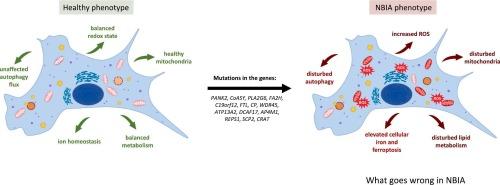Metabolic impairments in neurodegeneration with brain iron accumulation
IF 2.7
2区 生物学
Q2 BIOCHEMISTRY & MOLECULAR BIOLOGY
引用次数: 0
Abstract
Neurodegeneration with brain iron accumulation (NBIA) is a broad, heterogeneous group of rare inherited diseases (1–3 patients/1,000,000 people) characterized by progressive symptoms associated with excessive abnormal iron deposition in the brain. Approximately 15,000–20,000 individuals worldwide are estimated to be affected by NBIA. NBIA is usually associated with slowly progressive pyramidal and extrapyramidal symptoms, axonal motor neuropathy, optic nerve atrophy, cognitive impairment and neuropsychiatric disorders. To date, eleven subtypes of NBIA have been described and the most common ones include pantothenate kinase-associated neurodegeneration (PKAN), PLA2G6-associated neurodegeneration (PLAN), mitochondrial membrane protein-associated neurodegeneration (MPAN) and beta-propeller protein-associated neurodegeneration (BPAN). We present a comprehensive overview of the evidence for disturbed cellular homeostasis and metabolic alterations in NBIA variants, with a careful focus on mitochondrial bioenergetics and lipid metabolism which drives a new perspective in understanding the course of this infrequent malady.

神经退行性病变中的代谢损伤与脑铁积聚。
脑铁积聚性神经变性(NBIA)是一类广泛、异质性的罕见遗传性疾病(1-3 名患者/1,000,000 人),其特征是与脑内过量异常铁沉积有关的进行性症状。据估计,全球约有 15,000-20,000 人受到 NBIA 的影响。NBIA 通常伴有缓慢进展的锥体和锥体外系症状、轴索运动神经病变、视神经萎缩、认知障碍和神经精神障碍。迄今为止,已描述了 11 种 NBIA 亚型,其中最常见的包括泛酸激酶相关神经变性(PKAN)、PLA2G6 相关神经变性(PLAN)、线粒体膜蛋白相关神经变性(MPAN)和β-螺旋桨蛋白相关神经变性(BPAN)。我们全面概述了 NBIA 变体中细胞稳态紊乱和代谢改变的证据,重点关注线粒体生物能和脂质代谢,为了解这种罕见疾病的病程提供了新的视角。
本文章由计算机程序翻译,如有差异,请以英文原文为准。
求助全文
约1分钟内获得全文
求助全文
来源期刊

Biochimica et Biophysica Acta-Bioenergetics
生物-生化与分子生物学
CiteScore
9.50
自引率
7.00%
发文量
363
审稿时长
92 days
期刊介绍:
BBA Bioenergetics covers the area of biological membranes involved in energy transfer and conversion. In particular, it focuses on the structures obtained by X-ray crystallography and other approaches, and molecular mechanisms of the components of photosynthesis, mitochondrial and bacterial respiration, oxidative phosphorylation, motility and transport. It spans applications of structural biology, molecular modeling, spectroscopy and biophysics in these systems, through bioenergetic aspects of mitochondrial biology including biomedicine aspects of energy metabolism in mitochondrial disorders, neurodegenerative diseases like Parkinson''s and Alzheimer''s, aging, diabetes and even cancer.
 求助内容:
求助内容: 应助结果提醒方式:
应助结果提醒方式:


